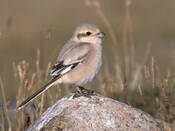search
classification
|
basic information
|
video
|
reports |
Steppe Grey Shrike
Lanius pallidirostris (Cassin, 1852)

|

|
|
|
2018-03-30
Ak-bulun, Issyk-kul region |
© Ivan Turkovskiy
|
|
Description
The Steppe Grey Shrike formerly was treated as subspecies of Great Grey Shrike and is very resemble it. From Great Grey Shrike it differs by the less contrast colors, by the buffy tinge of upper and underparts; the black mask is faint before the eyes. On males the upperparts are pale-grey, sometimes with pale-buffy tinge. The forehead is usually without white or rarely with slightly whitish on the base of upper mandible. The white supercilium is well expressed especially behind the eye. The white on the primaries and secondaries is well extensive and forms the large white speculum on the wing. The bases of central pair of tail feathers usually are black without white. The uppertail coverts are usually pale-grey. Underparts are white buffy tinged but without dark pattern.
Biology
The Steppe Grey Shrike is a resident bird migrating within its natural habitat or some southward of. Inhabits saxaul and Asiatic poplar forest, desert thickets and even in places devoid of tree or shrub vegetation, where it nests on artificial objects such as triangulation towers or electricity poles. Arrives early for nesting, early, in March or early April. Pairs breed 0.5 to 3 km one from another. Nests are built in trees and bushes (saxaul, Asiatic poplar, willow, Calligonum sp., Atraphaxis sp.), among sticks of Imperial Eagle nests and on brackets of electricity or telegraph poles at 0.5-5 m off the ground. Both birds of the couple build the nest of thin twigs, grass and rootlets, lined with plenty of vegetation fluff and hair (mostly sheep wool). It takes 3 to 7 days to build a nest. Egg laying in early April to late May make clutches of 5 to 8 eggs. Only female incubates for 15-16 days while male feeds her. Both parents bring up the juveniles, who fledge at 12-13 days, in early May to late June. After juveniles fledge, the pair builds new nest 80-120 m away from the first one. When the female begins to incubate at this new nest, she stops feeding the first brood. After the second brood hatches out, male stops feeding first fledglings and both male and female concentrate on feeding second brood. This pattern is typical in the Kyzylkum desert, where these observations were made, but not yet known for other areas. Repeated breeding after loss of first nest is common. Autumn movement begins at the middle of August.
References
Gavrilov E. I., Gavrilov A. E. "The Birds of Kazakhstan". Almaty, 2005. Э.И.Гаврилов. "Фауна и распространение птиц Казахстана". Алматы, 1999.
unidentified birds
Анатолий Таран: Желтогрудый князёк
xxxx: плохо видно, но мне кажется это кулики либо песочники.
хххх: да. это крохаль, но скорее всего средний. длинноносый который. из за красной шеи. много лет не мог определить вид этой птицы. гугл мугл не помогад. [....]








